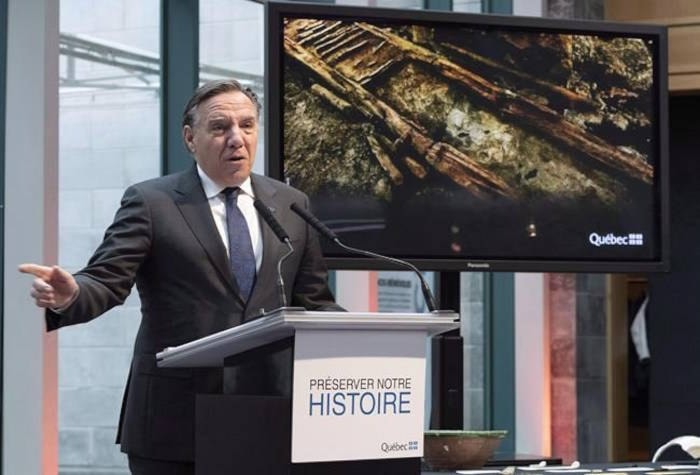In the knee-deep mud of a future Quebec City condominium project, it was a spot of dark soil that led archeologists to uncover the edge of an axe-hewn wooden stake, preserved in wet clay far below the surface.
What eventually emerged last fall was hailed as a major find: a 20-metre segment of a wood palisade, built in 1693 by French troops and settlers to protect against attacks from British and Indigenous groups.
“For the history of Quebec City, it’s extremely important, because these were the first ramparts,” said Jean-Yves Pintal, who led the dig on behalf of archeological firm Ruralys. “There were small forts before that,” he said, but nothing like the defence these palisades offered.
But for some, the discovery of part of the 325-year-old Beaucours palisade was a reminder that North America’s best-preserved fortified city still has secrets to reveal, including a major mystery that has stumped archeologists for over a century.
“The palisade was one of a few secrets that remained to be cleared up or understood,” Quebec City Mayor Regis Labeaume said at a November press conference announcing the find. “There’s one left, and that’s Champlain’s tomb.”
Samuel de Champlain, the French explorer who founded Quebec City in 1608, has been dubbed “the father of New France.” His name graces streets, bridges, and a major lake on the Canada-U.S. border, but his final resting place remains unknown. Despite intense public interest and multiple efforts, archeologists say they’re no closer to finding his tomb.
While Labeaume’s remark was made jokingly, the search for the grave has become a minor sore spot for archeologists, said Pintal. Even the announcement of one of Quebec City’s earliest fortifications was overshadowed by remarks about the search for the founder.
“Every time we dig a hole in Quebec City, people ask if we’re searching for Champlain,” he said with a laugh. “It’s a never-ending story.”
For independent archeologist Carl Lavoie, who has taken an interest in Champlain, the subject is no joking matter. Lavoie says past failed attempts to find the founder have somewhat “discredited” the subject and led to Champlain fatigue among some of his peers. But he sees no reason why the search should not be treated seriously.
“Every nation, every country would like to know where their founders, their great figures can be found,” he said. “The mayor may have said that with a smile, but I think that he’d also like to find him.”
Even Lavoie acknowledges the search is an uphill battle. Records suggest Champlain died on Christmas Day in 1635, and his remains were moved to a chapel that was later burned to the ground. A Jesuit text from 1642 refers to a priest who was buried alongside the founder and another friend, but there is no record of where that burial took place.
“It is likely the remains were moved, but nobody knows when or where,” Lavoie said.
Serious efforts to find the tomb began in the mid-1800s. Scientists began “digging left and right” to find Champlain, he said, but without success. More recently, an archeologist who shared the name of former Quebec premier Rene Levesque led a series of digs in the 1980s and 1990s that proved equally fruitless.
Lavoie believes the location of the original “Champlain chapel” to which his remains were moved has been found in the old city. Lavoie believes there’s a good chance Champlain could be lying somewhere beneath Quebec City’s basilica, either on his own or in a common grave.
But the search for the founder’s remains are at a standstill, and even if found, they would not be easy to identify. Champlain fathered no children and left no descendants, which eliminates the possibility of DNA matching. To confirm the identity, researchers would have to match up remains with what little that is known about Champlain physically — for example traces of the arrow wounds he suffered during a 1613 conflict with the Iroquois.
While it’s a long shot, Lavoie points to the case of English King Richard III — whose remains were found under a Leicester parking lot in 2012 — as a reason to not give up. “We can still dream a little,” he said.
Pintal agrees it would be wonderful to finally find Champlain — if only so people can stop asking him about it. But for now, his focus remains firmly on learning more about the newly discovered palisade, which he says has great symbolic importance for the city.
He’s hoping the discovery will shed light on the construction techniques of the day and teach researchers about the role both civilians and the military played in shoring up the city’s defences. “The fact that France recognized that Quebec deserved to be protected by ramparts, it’s a bit like a consecration,” he said. “France recognized Quebec as the colonial capital of North America.”
He said the centuries-old wood risked rapid deterioration once exposed to air. It has since been moved to a temperature-controlled warehouse where it can be preserved to ensure that its secrets, at least, won’t be among those to disappear.
The Canadian Press
